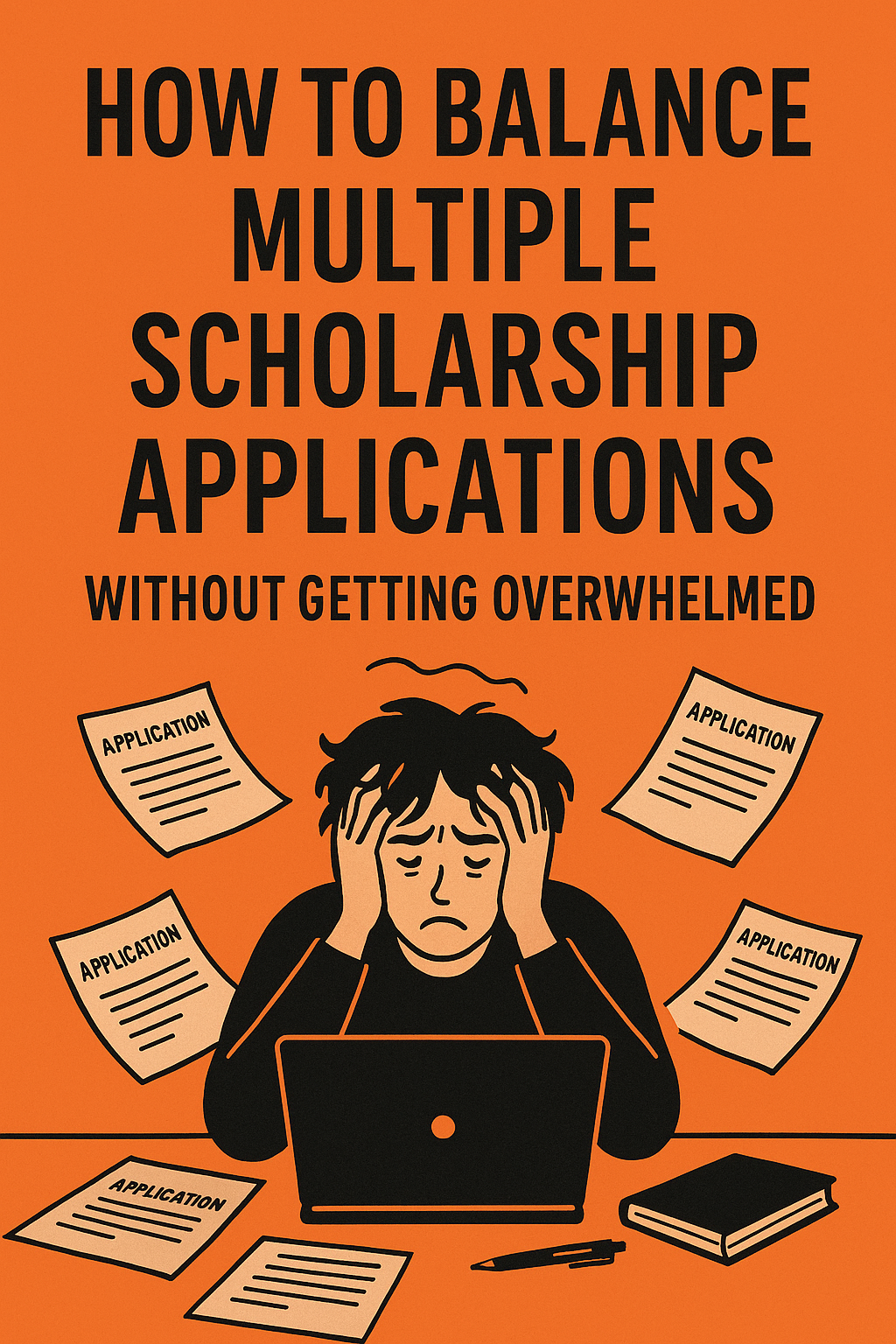
How to Balance Multiple Scholarship Applications Without Getting Overwhelmed

Scholarships can open doors to life-changing academic opportunities. But if you’ve ever tried applying for several at once, you already know—it's no small feat. Between navigating eligibility requirements, crafting compelling essays, and keeping up with deadlines, the process can feel like a job on its own.
So how do you stay organized and motivated without getting overwhelmed? The secret lies in working smarter, not harder. In this article, we’ll walk you through practical steps to manage multiple scholarship applications without losing your balance.
1. Build a Master Scholarship Tracker
The first step is getting everything in one place. Create a simple spreadsheet to serve as your scholarship dashboard. It doesn’t have to be fancy; a table with key details will do the trick. Your tracker should include:
- Scholarship name
- Website or source
- Application deadline
- Eligibility criteria
- Required documents
- Status (Not started / In progress / Submitted)
- Notes or links
This one document becomes your “control center,” helping you stay focused and avoid missing important deadlines.
Pro tip: Use color codes, green for submitted, yellow for in progress, and red for pending, to visualize your progress.
2. Use a Calendar to Manage Deadlines
Once you’ve listed the deadlines in your tracker, transfer each one to a digital calendar: Google Calendar, Notion, or even a mobile reminder app. Set two reminders:
- One a week before the deadline
- Another 48 hours before the due date
Having visual cues can drastically reduce last-minute panic and help you spread your work over time instead of cramming.
3. Work Smarter: Reuse and Adapt Content
Most scholarships will ask you to write a personal statement or an essay around similar themes:
- Why do you deserve this scholarship?
- What are your career goals?
- Describe a challenge you’ve overcome.
Rather than starting from scratch every time, develop a strong base essay and then tweak it to match each scholarship’s specific prompt or tone.
This not only saves time but also helps maintain consistency in your applications.
4. Batch Similar Tasks
Don’t jump from one scholarship to another at random. Instead, group similar tasks together. For example:
- Spend one day drafting multiple essays.
- Use another day to request transcripts and documents.
- Reserve a third day for proofreading and final reviews.
Batching tasks minimizes mental fatigue and improves focus because you’re not constantly switching contexts.
5. Set a Weekly Application Target
Applying to 20 scholarships is less intimidating when you break it down. Set a realistic weekly goal, like applying to two or three scholarships per week.
Smaller goals feel achievable, keep you motivated, and prevent burnout. Plus, with each submission, your confidence grows.
6. Keep Documents and Templates Ready
Create a dedicated folder on your device or cloud storage for scholarship-related materials. Organize it into subfolders:
- Academic documents (transcripts, certificates)
- Essays (named and dated clearly)
- Recommendation letters
- Resume or CV
- Identity documents (e.g., passport, ID)
Naming files clearly (e.g., “Chizitere_Munachi_ScholarshipEssay_2025.pdf”) ensures that when the time comes, you’re not scrambling through your downloads folder.
7. Get Recommendation Letters Early
Waiting until the last minute to ask for a reference is a recipe for stress. Most scholarship reviewers want strong, thoughtful letters, not rushed notes written in a panic.
Reach out to your referees at least 2–3 weeks before you need the letter. Send them:
- A short summary of your goals
- Information about the scholarship
- Your resume or academic background
- A clear deadline
This helps them write a personalized and impactful letter and helps you breathe easier.
8. Don’t Forget Self-Care
It’s easy to get consumed by deadlines, especially when you’re juggling school, family, or work alongside scholarship applications. But remember: burnout doesn’t win scholarships.
- Take short breaks during long study or writing sessions.
- Drink water, rest, and get some sunlight.
- Don’t beat yourself up for missing a deadline; refocus and try again.
A calm, focused mind is your best tool for crafting strong applications.
Final Thoughts
Balancing multiple scholarship applications is challenging but entirely doable with the right strategy. By staying organized, working efficiently, and taking care of yourself, you give yourself the best chance at success.
Remember, you don’t need to apply to every scholarship. Focus on the ones where you’re eligible, qualified, and genuinely interested.
Be consistent, stay patient, and keep your eyes on the goal: funding your future.
You may also like
0 Comments
Leave a Reply
Subscribe Today!
Subscribe to our weekly Newsletter and receive updates via email.
Scholarships by Category
- Training (35)
- PhD (62)
- Undergraduate (188)
- Masters (158)
- Fully Funded (74)
- postgraduate (37)
- Contests (11)
- Health (18)
- Grants (25)
- Entrepreneurs (22)
- Women (19)
- Partial funding (92)
- Law (5)
- Bachelors (15)
- Nursing (9)
- Medicine (16)
- Internship (25)
- College School (3)
- MBA (9)
- Tech (8)
- Fellowship (33)
- Postdoctoral (10)
- STEM (2)
- Leadership (3)
Scholarship Awarding Countries
- Nigeria (42)
- United Kingdom (135)
- Germany (17)
- Netherlands (5)
- Italy (2)
- Switzerland (11)
- United States (58)
- Canada (113)
- South Africa (9)
- Australia (24)
- Indonesia (1)
- Brazil (1)
- France (2)
- Singapore (2)
- Saudi Arabia (2)
- Belgium (1)
- United Arab Emirates (1)
- Ireland (2)
- Uganda (1)
- Rwanda (1)
- New Zealand (4)
- Japan (5)
- Denmark (5)
- Morocco (1)
- Ghana (4)
- Thailand (1)
- Kenya (3)
- Slovakia (1)
- Brunei (1)
- Albania (1)
Eligible Regions
Eligible Countries
- Nigeria (21)
- United Kingdom (18)
- Germany (15)
- Canada (21)
- United States (20)
- Ghana (17)
- Kenya (17)
- Sierra Leone (17)
- South Africa (17)
- Algeria (16)
- Angola (16)
- Benin (16)
- Botswana (16)
- Burkina Faso (16)
- Burundi (16)
- Cabo Verde (16)
- Cameroon (16)
- Central African Republic (16)
- Chad (16)
- Comoros (16)
- Democratic Republic of the Congo (16)
- Republic of the Congo (16)
- Cote d'Ivoire (16)
- Djibouti (16)
- Egypt (16)
- Equatorial Guinea (16)
- Eritrea (16)
- Eswatini (16)
- Ethiopia (16)
- Gabon (16)
Scholarships by School
- King's College London (2)
- University of the Highlands & Islands Rural and Islands (UHI) (1)
- University of Pisa (1)
- University of Michigan (1)
- Hartpury University (1)
- University of Huddersfield (1)
- Leeds Beckett University (1)
- Kingston University (2)
- University of Buckingham (2)
- Cardiff University (2)
- University of Chichester (1)
- University of East London (1)
- University of Edinburgh (2)
- University of Essex (1)
- Falmouth University (1)
- CQUniversity Australia (1)
- University of Prince Edward Island (2)
- Yukon University (1)
- Dalhousie University (3)
- Universitas Sebelas Maret (UNS) (1)
- McGill University (2)
- Royal Holloway University of London (2)
- School of Oriental and African Studies (SOAS) (2)
- Carnegie Mellon University (CMU) (1)
- Nanyang Technological University (NTU) (1)
- University of Exeter (4)
- London Metropolitan University (1)
- Hult International Business School (2)
- Teesside University (1)
- Middlesex University London (1)
Scholarships by Sponsors
- Economic Community of West African States (ECOWAS) (1)
- King’s College London (2)
- University of the Highlands & Islands Rural and Islands (UHI) (1)
- DAAD (German Academic Exchange Service (4)
- Dutch Ministry of Foreign Affairs (1)
- Universita Di Pisa (1)
- One Young World (2)
- Scholarship America (2)
- University of Michigan (1)
- Hartpury University (1)
- University of Huddersfield (1)
- Awesome Foundation (1)
- Leeds Beckett University (1)
- Kingston University (2)
- University of Leicester (5)
- Kochhar & Co (1)
- Indspire Canada (1)
- Skills Competencies Ontario (1)
- Girl in Bloom (1)
- Fidelity Bank (1)
- University of Buckingham (2)
- Cardiff University (2)
- University of Chichester (1)
- University of East London (1)
- University of Edinburgh (1)
- University of Essex (1)
- Falmouth University (1)
- The Harris Brand Foundation (THBF) (1)
- Zutari (1)
- CQUniversity Australia (1)
Latest Scholarship Tips

How Can You Create a Powerful Resume as a Student Without Work Experience?
This guide teaches students how to create an impre...

Top 10 Most Affordable Universities in Canada for International Students
Canada is a popular destination for international...
.png)
25 Proven Study Techniques for Academic Success in 2025
This detailed blog post explores 25 powerful study...

Mastering Student Life: 10 Time-Saving Tools and Techniques That Actually Work
Managing student life can be overwhelming, but it...

Essential Guide to Studying Abroad: All You Need to Know
Studying abroad is a life-changing opportunity tha...

Top 15 Scholarships and Funding Opportunities in Canada for 2025 | Study in Canada
Looking to study in Canada in 2025? We've compiled...
Advertising
Amazon Essentials Women's Active FormFlex Buttery Soft Light Support Crop Tank with Bra and Contrast Trim
The Plus Catalog: the all-you-can-listen catalog including thousands of audiobooks, podcasts, and originals
Jurassic World Rebirth Quetzalcoatlus Air Dinosaur Pullover Hoodie
Jurassic World Rebirth Velociraptor Covert Mission




